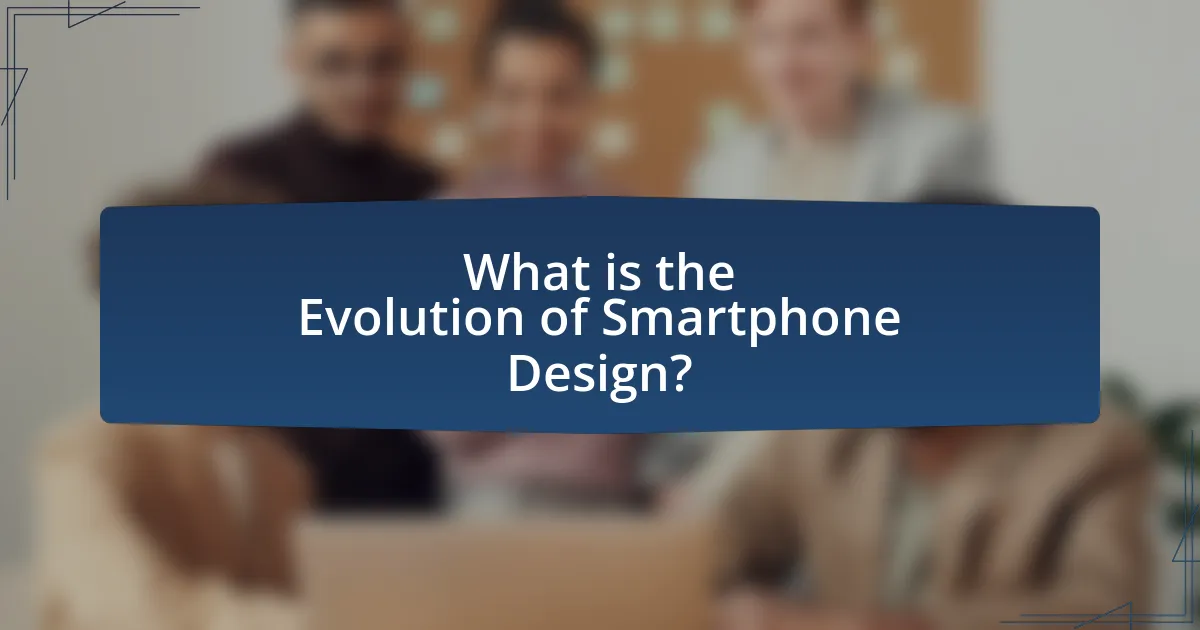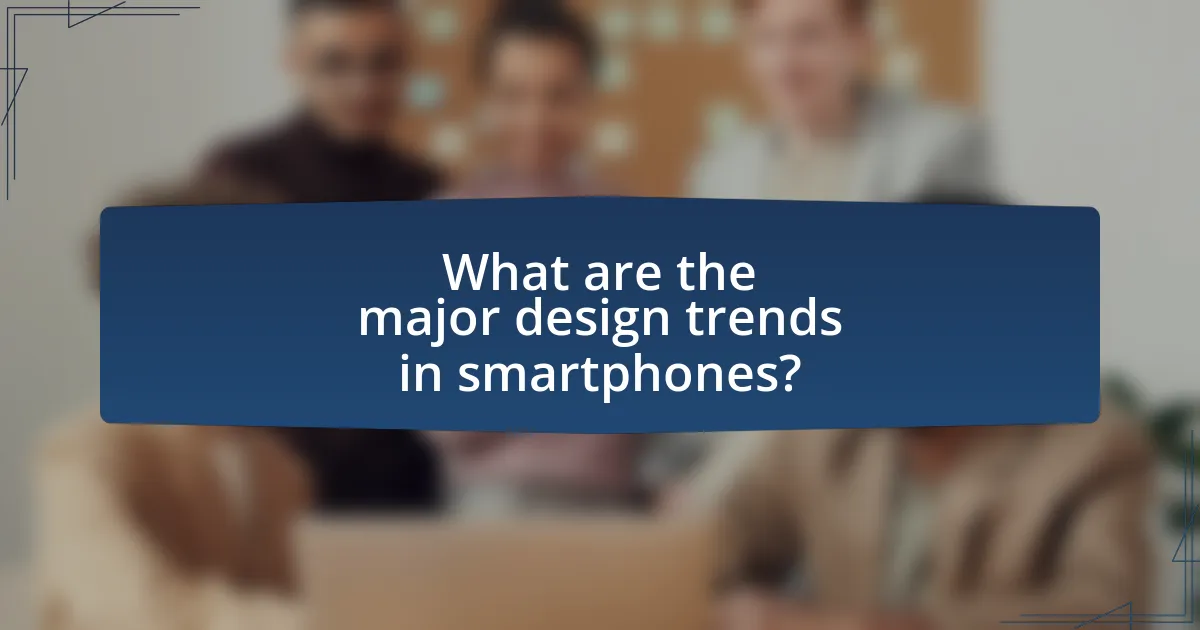The article examines the evolution of smartphone design, tracing its journey from the bulky IBM Simon in 1994 to the sleek, minimalist devices of today. Key milestones include the introduction of touchscreens with the Apple iPhone in 2007, the rise of edge-to-edge displays, and the emergence of foldable screens. It highlights the importance of design in enhancing user experience, functionality, and brand perception, while also addressing consumer preferences for aesthetics, sustainability, and advanced features. The discussion encompasses the impact of materials, design trends, and future innovations in the smartphone industry.

What is the Evolution of Smartphone Design?
The evolution of smartphone design has transitioned from bulky, brick-like devices to sleek, minimalist forms. Initially, smartphones like the IBM Simon in 1994 featured large dimensions and limited functionality, resembling handheld computers. As technology advanced, the introduction of touchscreens, starting with the Apple iPhone in 2007, revolutionized design by eliminating physical keyboards and allowing for larger displays. This shift led to thinner profiles and the use of premium materials such as glass and aluminum, enhancing aesthetics and user experience. By 2020, designs further evolved with edge-to-edge displays and foldable screens, exemplified by devices like the Samsung Galaxy Z Fold, showcasing the industry’s focus on maximizing screen real estate while maintaining portability.
How has smartphone design changed over the years?
Smartphone design has evolved significantly from bulky, brick-like devices to sleek, minimalist models. Initially, smartphones featured physical keyboards and thick casings, exemplified by models like the IBM Simon in 1994, which was 0.7 inches thick. Over the years, the introduction of touchscreens, starting with the iPhone in 2007, led to thinner profiles and larger displays, with the average thickness of smartphones decreasing to around 0.3 inches by 2023. Additionally, materials have shifted from plastic to premium glass and metal, enhancing aesthetics and durability. The trend towards edge-to-edge displays has further minimized bezels, maximizing screen real estate, as seen in devices like the Samsung Galaxy S series.
What were the key milestones in smartphone design history?
The key milestones in smartphone design history include the introduction of the IBM Simon Personal Communicator in 1994, which is considered the first smartphone due to its touchscreen and email capabilities. In 2007, Apple launched the iPhone, revolutionizing smartphone design with its multi-touch interface and sleek aesthetics, setting a new standard for user experience. The introduction of Android in the same year allowed for greater customization and variety in smartphone design. In 2010, the Samsung Galaxy S series began to popularize larger screens and high-resolution displays, further influencing design trends. The shift towards bezel-less designs began in 2017 with the iPhone X, which eliminated the home button and maximized screen real estate. Each of these milestones significantly impacted the evolution of smartphone design, shaping the devices we use today.
How did early designs influence modern smartphones?
Early designs of smartphones, such as the IBM Simon and Nokia 9000 Communicator, laid the foundational principles for modern smartphones by integrating essential features like touchscreens, email capabilities, and internet connectivity. These early devices introduced the concept of a handheld computer, which influenced the development of user interfaces and app ecosystems seen in contemporary smartphones. For instance, the IBM Simon, released in 1994, was the first device to combine a mobile phone with PDA functionalities, showcasing the potential for multifunctional devices. Similarly, the Nokia 9000, launched in 1996, featured a full QWERTY keyboard and web browsing, setting a precedent for the design and functionality of future smartphones. These innovations directly contributed to the evolution of smartphone design, leading to the sleek, powerful devices we use today.
Why is smartphone design important to consumers?
Smartphone design is important to consumers because it directly influences usability, aesthetic appeal, and brand perception. A well-designed smartphone enhances user experience through intuitive interfaces and ergonomic features, making it easier for consumers to navigate and interact with their devices. Additionally, attractive designs can create emotional connections, leading to increased brand loyalty; for instance, Apple’s focus on sleek, minimalist design has contributed to its strong market presence. Research indicates that 70% of consumers consider design as a key factor in their purchasing decisions, highlighting its significance in the competitive smartphone market.
What role does design play in user experience?
Design plays a crucial role in user experience by shaping how users interact with a product and influencing their overall satisfaction. Effective design enhances usability, making interfaces intuitive and accessible, which directly impacts user engagement and retention. For instance, a study by the Nielsen Norman Group found that users are 5 times more likely to abandon a task if the interface is not user-friendly. This highlights that thoughtful design not only improves functionality but also fosters a positive emotional connection between the user and the product, ultimately driving brand loyalty.
How does design impact the functionality of smartphones?
Design significantly impacts the functionality of smartphones by influencing user interface, ergonomics, and component integration. A well-thought-out design enhances user experience by ensuring intuitive navigation and accessibility, which are critical for effective interaction with the device. For instance, the introduction of larger screens in sleek designs has facilitated better multimedia consumption and multitasking capabilities, as evidenced by the rise of phablets that combine phone and tablet features. Additionally, design choices such as the placement of buttons and ports can affect how easily users can operate the device and access its features, impacting overall usability. Furthermore, advancements in materials and manufacturing processes have allowed for thinner devices without compromising battery life or performance, demonstrating that design directly correlates with functional improvements in smartphones.

What are the major design trends in smartphones?
The major design trends in smartphones include minimalism, bezel-less displays, and sustainable materials. Minimalism emphasizes sleek, simple designs with fewer physical buttons and a focus on screen real estate, as seen in models like the iPhone X, which introduced a nearly edge-to-edge display. Bezel-less displays have become increasingly popular, with manufacturers like Samsung and Xiaomi pushing the boundaries of screen-to-body ratios, achieving over 90% in some models. Additionally, the use of sustainable materials, such as recycled aluminum and glass, is gaining traction as brands like Apple and Fairphone prioritize eco-friendly practices in their designs. These trends reflect consumer preferences for aesthetics, functionality, and environmental responsibility in smartphone design.
How have materials used in smartphone design evolved?
Materials used in smartphone design have evolved from primarily plastic and metal to advanced composites, glass, and ceramics. Initially, early smartphones utilized plastic casings for lightweight and cost-effective designs, but as consumer preferences shifted towards aesthetics and durability, manufacturers began incorporating aluminum and stainless steel for structural integrity. The introduction of Gorilla Glass in the early 2010s marked a significant advancement, providing scratch resistance and improved durability. More recently, manufacturers have explored ceramic materials for premium models, enhancing both aesthetics and strength. This evolution reflects a trend towards combining functionality with design, as seen in flagship models that prioritize both performance and visual appeal.
What materials were commonly used in early smartphones?
Early smartphones commonly utilized materials such as plastic, glass, and aluminum. Plastic was frequently used for the casing due to its lightweight and cost-effective properties, while glass was employed for screens to provide clarity and touch sensitivity. Aluminum became popular for its durability and premium feel, especially in later models. These materials were chosen to balance functionality, aesthetics, and manufacturing costs, reflecting the technological capabilities and design trends of the time.
How do modern materials enhance smartphone design?
Modern materials enhance smartphone design by enabling thinner, lighter, and more durable devices. Advanced materials such as aluminum, glass, and composites provide structural integrity while allowing for sleek aesthetics. For instance, the use of Gorilla Glass has significantly improved scratch resistance and durability, which is crucial for everyday use. Additionally, materials like carbon fiber and high-grade plastics contribute to weight reduction without compromising strength, facilitating ergonomic designs that are comfortable to hold. These innovations not only improve functionality but also allow for more sophisticated design elements, such as edge-to-edge displays and intricate finishes, which are essential in the competitive smartphone market.
What design features have become standard in smartphones?
Standard design features in smartphones include large touchscreens, minimal bezels, and slim profiles. These features have evolved due to consumer demand for more immersive displays and portability. For instance, the transition from physical keyboards to full touchscreen interfaces began with the introduction of the iPhone in 2007, which set a precedent for future designs. Additionally, the adoption of materials like glass and aluminum has become common, enhancing aesthetics and durability. The trend towards edge-to-edge displays has also gained traction, with many manufacturers aiming for a seamless look that maximizes screen real estate.
How have screen sizes and resolutions changed?
Screen sizes and resolutions have significantly increased over the years, reflecting advancements in technology and consumer demand. In the early 2000s, smartphones typically featured screens around 2 to 3 inches with resolutions of 240×320 pixels. By 2023, average screen sizes have expanded to approximately 6 to 7 inches, with resolutions commonly reaching Full HD (1920×1080 pixels) or higher, such as 4K (3840×2160 pixels) in premium models. This evolution is driven by the need for better multimedia experiences, gaming, and productivity, as well as the introduction of technologies like OLED and AMOLED displays, which enhance color accuracy and contrast.
What advancements have been made in camera design?
Recent advancements in camera design include the integration of multiple lenses, improved sensor technology, and enhanced computational photography capabilities. The introduction of multi-lens systems allows for varied focal lengths and improved depth perception, enabling features like portrait mode and optical zoom. Additionally, advancements in sensor technology, such as larger sensors and improved low-light performance, have significantly enhanced image quality. Computational photography techniques, including HDR imaging and AI-driven enhancements, further optimize photos by processing images in real-time to improve clarity and detail. These innovations collectively contribute to the evolution of smartphone cameras, making them more versatile and capable than ever before.

What are the future trends in smartphone design?
Future trends in smartphone design include foldable displays, enhanced sustainability, and integration of artificial intelligence. Foldable displays allow for larger screens in compact devices, as seen in models like the Samsung Galaxy Z Fold series, which has gained significant market traction since its release. Enhanced sustainability focuses on using eco-friendly materials and modular designs for easier repairs, aligning with consumer demand for environmentally responsible products. Integration of artificial intelligence enhances user experience through personalized features, as demonstrated by AI-driven camera systems that optimize photo quality based on scene recognition. These trends reflect the industry’s response to consumer preferences and technological advancements.
How is technology influencing future smartphone designs?
Technology is significantly influencing future smartphone designs by enabling advancements in materials, display technology, and artificial intelligence integration. Innovations such as foldable screens and lightweight materials like graphene allow for more versatile and durable devices, while OLED and microLED technologies enhance display quality and energy efficiency. Furthermore, the incorporation of AI enhances user experience through personalized features and improved camera capabilities, as seen in devices utilizing computational photography. These technological advancements are reshaping the aesthetics and functionality of smartphones, leading to sleeker, more efficient designs that cater to evolving consumer demands.
What role will foldable and flexible screens play?
Foldable and flexible screens will play a crucial role in enhancing smartphone design by enabling more compact, versatile, and innovative form factors. These screens allow devices to maintain a larger display area while being more portable, as seen in models like the Samsung Galaxy Z Fold, which offers a tablet-like experience in a pocket-sized device. The technology behind foldable screens, such as OLED and AMOLED, provides durability and flexibility, allowing manufacturers to create devices that can bend without compromising display quality. This shift not only caters to consumer demand for larger screens but also paves the way for new user experiences, such as multitasking and immersive gaming, thereby driving the evolution of smartphone design from traditional rigid structures to more dynamic and adaptable forms.
How might artificial intelligence shape smartphone interfaces?
Artificial intelligence will shape smartphone interfaces by enabling more intuitive and personalized user experiences. AI algorithms can analyze user behavior and preferences, allowing interfaces to adapt dynamically to individual needs, such as suggesting apps or features based on usage patterns. For instance, machine learning models can optimize voice recognition and natural language processing, enhancing virtual assistants like Siri and Google Assistant, making them more responsive and context-aware. Research indicates that 70% of users prefer personalized experiences, highlighting the demand for AI-driven interfaces that cater to specific user habits and preferences.
What consumer preferences are shaping future designs?
Consumer preferences shaping future smartphone designs include a demand for sleek aesthetics, enhanced functionality, and sustainability. Users increasingly favor devices that are visually appealing and lightweight, leading manufacturers to prioritize minimalist designs and premium materials. Additionally, consumers are seeking multifunctionality, such as improved camera capabilities and longer battery life, which drives innovation in hardware and software integration. Sustainability is also a significant factor, with a growing preference for eco-friendly materials and practices, as evidenced by a 2022 survey indicating that 70% of consumers are willing to pay more for sustainable products. These preferences collectively influence the direction of smartphone design, pushing brands to adapt and innovate to meet evolving consumer expectations.
How important is sustainability in smartphone design?
Sustainability is critically important in smartphone design, as it addresses environmental concerns and consumer demand for eco-friendly products. The smartphone industry is responsible for significant electronic waste, with over 50 million tons generated annually, highlighting the need for sustainable practices. Manufacturers are increasingly adopting recyclable materials, energy-efficient production processes, and modular designs to extend product life and reduce waste. For instance, companies like Apple and Samsung have committed to using recycled materials in their devices, aiming for a circular economy. This shift not only meets regulatory requirements but also aligns with consumer preferences, as studies show that 70% of consumers consider sustainability when purchasing electronics.
What features do consumers prioritize in new designs?
Consumers prioritize functionality, aesthetics, and user experience in new smartphone designs. Research indicates that 70% of consumers value a sleek and modern appearance, while 65% prioritize features such as battery life and camera quality. Additionally, ease of use and intuitive interfaces are critical, with 60% of users indicating that they prefer designs that enhance usability. These preferences reflect a broader trend towards devices that not only look good but also perform efficiently and meet practical needs.
What are some best practices for smartphone design?
Best practices for smartphone design include prioritizing user experience, ensuring ergonomic form factors, and optimizing performance. User experience can be enhanced through intuitive interfaces and responsive touchscreens, which are critical for user satisfaction. Ergonomic design, such as rounded edges and lightweight materials, improves comfort during prolonged use. Performance optimization involves using efficient processors and adequate battery life to meet user demands, as evidenced by the increasing reliance on smartphones for multitasking and high-performance applications. These practices are supported by industry trends showing that user-centric designs lead to higher customer retention and satisfaction rates.
How can designers balance aesthetics and functionality?
Designers can balance aesthetics and functionality by integrating user-centered design principles that prioritize both visual appeal and practical usability. This approach involves conducting user research to understand needs and preferences, which informs design choices that enhance both form and function. For instance, the use of materials that are visually pleasing yet durable, such as aluminum or glass, exemplifies this balance in smartphone design. Additionally, ergonomic considerations ensure that devices are comfortable to hold and use, which is crucial for functionality. Studies show that products designed with both aesthetics and usability in mind lead to higher user satisfaction and engagement, as evidenced by the success of brands like Apple, which consistently merges sleek design with intuitive functionality in their devices.
What considerations should be made for user accessibility?
User accessibility considerations include ensuring that smartphone designs accommodate individuals with diverse needs, such as visual, auditory, and motor impairments. Features like screen readers, voice commands, adjustable text sizes, and tactile feedback enhance usability for people with disabilities. According to the World Health Organization, approximately 15% of the global population experiences some form of disability, highlighting the importance of inclusive design. Additionally, compliance with accessibility standards, such as the Web Content Accessibility Guidelines (WCAG), ensures that smartphone interfaces are navigable and usable for everyone.




